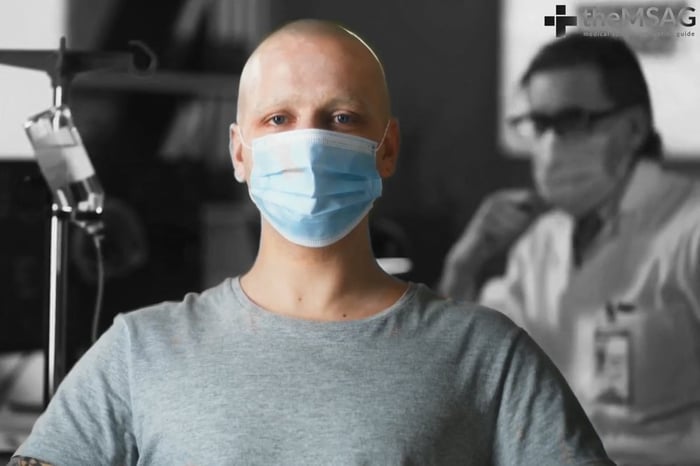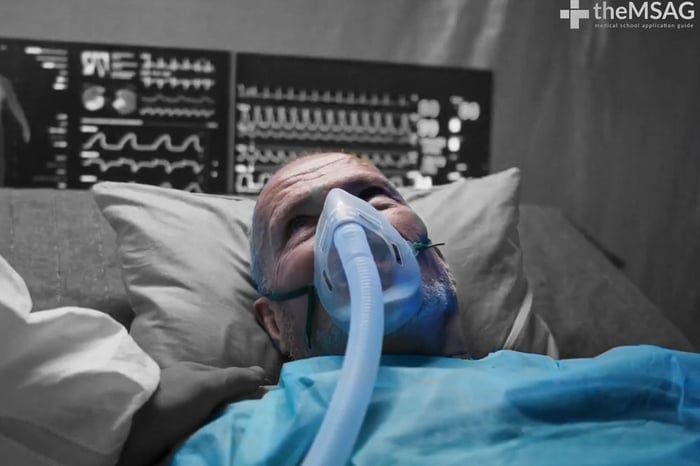
COVID-19 - Impact on patients
In our previous posts, we have considered in detail how the COVID-19 pandemic was handled by the government and how this affected the population in general. With any hot topic question posed to you in a medical school interview it is important to consider the perspectives of the public, patients and healthcare professionals. To help you prepare for your interview and to gain a better understanding of how to approach specific question types why not check out our live online interview course.
In this post, we will focus on how the pandemic has impacted the lives of patients.
Table of Contents
- General Impact
- Impact on chronic conditions
- Cancer Patients
- The Over 60s Population
- Impact on Care Homes
- Impact on Minority Ethnic Groups
- Conclusion
General Impact
The COVID-19 pandemic has greatly impacted the ability of the National Health Service to deliver its core services. The NHS has had to make tough decisions in order to ensure there is enough capacity within the system to manage the large influx of patients with COVID-19. Further to the reduced provision of NHS services during the pandemic, patients have also been too scared to access healthcare in person for fear of contracting COVID-19. An example of this was seen in ophthalmology departments across Wales. Ophthalmology is a branch of medicine and surgery which deals with the diagnosis and treatment of eye disorders. Sali Davis, the head of Optometry Wales, said that “People with serious eye conditions are sitting at home, slowly going blind” and that some patients were “terrified” to leave their house because of COVID-19. This unfortunate combination of reduced healthcare services and patients being afraid to seek help has meant that millions of patients have missed appointments. This is one hidden impact of the COVID-19 pandemic.
Data analysis by the British Medical Association estimates that from April to June 2020, there was between 1.32 and 1.50 million fewer elective admissions than would usually be expected for this time period. An elective admission is a planned, or non-emergency, admission into hospital such as a planned hip replacement operation or planned cataract surgery. The data also showed that there were between 2.47 and 2.60 million fewer first outpatient attendances. Outpatient clinics provide preventative, diagnostic and treatment services within hospitals. This is often where people are first diagnosed and assessed within specialist departments.
During the pandemic patients who were categorised as “clinically extremely vulnerable” were advised to shield. This meant they were advised to not leave their homes and to minimise all face-to-face contact. This affected more than 2.2 million patients who were affected with conditions such as severe respiratory disease, specific cancers, and illnesses affecting the immune system. Arrangements had to be put in place to deliver food and medicines to these patients. Although these measures were designed to protect these patients' from COVID-19 it came at a cost to their physical and mental health. A survey by the Office of National Statistics found that 35% of people shielding said that their mental health had deteriorated. 20% of patients who were shielding said that they were unable to access certain types of their care, such as tests and scans, and 10% reported that they were unable to access any care at all since shielding.
Impact on chronic conditions
A chronic condition is a disease or illness that lasts for more than three months and is long-term. Examples include diabetes, COPD and high blood pressure (also known as hypertension). Patients with chronic conditions have been significantly impacted by the COVID-19 pandemic. Let’s review each of these chronic conditions in more detail.
Diabetes
Approximately 4 million people in the UK have a diagnosis of diabetes; this equates to around 6% of the total population of the UK. People with diabetes have been found to be at increased risk of severe illness if they contract COVID-19. A study conducted by NHS England revealed that one in three people who have died in hospital secondary to COVID-19 also had diabetes.
The Lancet medical journal published a whole population study looking at the risks of in-hospital death from COVID-19 in England. The study found that people with either type 1 or type 2 diabetes had a significantly increased risk of dying from COVID-19 compared to non-diabetic patients.
Diabetic patients require regular check-ups throughout the year to monitor their condition and to limit the development or progression of related complications such as diabetic foot or eye disease. During the pandemic there has been a shift to diabetes appointments being offered online or via phone where possible, and patients have been encouraged to take more responsibility to closely monitor things like their blood sugar and feet themselves. Charities such as Diabetes UK have been supporting people with diabetes by creating educational resources and videos for patients. The risk of infection with COVID-19 would be reduced with fewer hospital visits, but does it come at a cost to the care of their chronic condition?
Chronic Obstructive Pulmonary Disease (COPD)
Chronic obstructive pulmonary disease (COPD) is a lung condition that makes it difficult to empty air out of the lungs because the airways have become narrowed. In the UK, it is estimated that 3 million people have COPD. Treatment for COPD typically includes inhaler therapy and pulmonary rehabilitation. Pulmonary rehabilitation is a specialised programme of exercise and physiotherapy to help people manage their condition.
A study published in The Lancet demonstrated that patients with severe COPD were at higher risk of death from COVID-19. A different study assessed the impact of COVID-19 on patients with COPD in the UK. The results showed that patients with COPD were affected by reduced physical activity, increased anxiety and reductions in the number of visitors during lockdown. The data also revealed that patients with COPD were being treated more often for exacerbations i.e. acute worsenings of their condition. The researchers believe that the changes in these patients’ daily lives, such as increased anxiety and reduced physical activity, attributed to the increased number of COPD exacerbations.
High blood pressure (Hypertension)
High blood pressure, also called hypertension, is when the pressure in your blood vessels is unusually high. High blood pressure is often described as a ‘silent killer’ as it rarely causes symptoms, but is estimated to be responsible for 7.6 million deaths per annum worldwide. Persistent high blood pressure can increase your risk of many serious and potentially life-threatening health conditions such as heart attacks, strokes, and vascular dementia. High blood pressure affects more than 1 in 4 adults in England, which is around 12.5 million people.
Having high blood pressure alone does not categorise a patient for ‘shielding’. If hypertension is well controlled, the increased risk of this chronic condition with COVID-19 is relatively low. However, some evidence suggests that poorly controlled blood pressure is independently associated with an increased risk of death from COVID-19.
A cause of concern is that many people suffer from undiagnosed high blood pressure. In England alone there are an estimated five million people living with undiagnosed hypertension. Patients with high blood pressure usually have no symptoms, and it is usually detected by screening measures or by chance when patients attend an appointment for something unrelated. As less patients visit their doctor and more appointments are conducted virtually, there is a significant danger that many patients will remain undiagnosed with hypertension and continue to live with the associated risks.
Cancer patients
Cancer is a disease caused by changes to your DNA. These changes make certain cells divide uncontrollably and spread into surrounding tissues. In 2015, it was estimated that 2.5 million people in the UK were living with cancer, and an estimated 360,000 people in the UK are diagnosed with cancer every year.
Patients with cancer are at an increased risk of dying from COVID-19. The immune system and the ability to fight infection is reduced by cancer and its treatments. During the pandemic, doctors had to make difficult decisions regarding the ethical principles of beneficence and maleficence. They had to weigh up the benefits of chemotherapy with the dangers of bringing cancer patients, with already weakened immune systems, into hospital for treatment, risking their exposure to COVID-19. Read our blog on ‘The importance of Medical Ethics’ to learn more about discussing ethics in your interview.
The second issue to consider is that patients with cancer were classed as extremely clinical vulnerable and were asked to ‘shield’ and stay indoors. A cancer diagnosis is often a life-changing experience and is associated with higher levels of anxiety, distress, and depression. The support of family and friends as well as charity groups are vital to help patients cope better, but unfortunately the pandemic has created many barriers to provide this support. Some charities such as Macmillan Cancer Support are still providing extensive support to patients suffering from cancer both virtually and in-person, with the proper COVID-19 precautions.
Another serious concern is the reduction in diagnosis and treatment of cancer during the pandemic. The British Medical Association estimates that from April to June 2020 in England, there were approximately 280,000 fewer urgent cancer referrals. In addition there were 20,800 to 25,900 fewer patients starting first cancer treatments following a decision to treat. The initiation of cancer treatment is often highly time-dependent, and therefore delays in diagnosis and treatment onset could result in serious consequences for patients. A report by Macmillan Cancer Support estimated that across the UK there were around 50,000 ‘missing diagnoses’ of cancer as of October 2020.
The Over 60s Population
The risk of severe illness and death from COVID-19 is much higher in older patient populations. In the first few months of the pandemic 4 out of 5 people who died from COVID-19 were aged 70 and over.
The graph below shows the number of deaths, for a range of age groups, from COVID-19, per one thousand people in the population. It was created by Age UK (a leading charity for older people) using data from the UK government from the start of the pandemic up until the end of May 2020.
In the 60-69 age group, fewer than 1 in 1000 people died from COVID-19. For those aged 90 and over this figure increased to 18 in every 1,000 people. Males also have a higher risk of death from COVID-19 than females in every age group.
The next graph is from the Intensive Care National Audit and Research Centre. It shows the survival rate of patients in critical care with COVID-19 per age group. The blue portion of the bar represents patients who were discharged alive and the orange portion represents patients who died in critical care. This demonstrates that approximately 2 out of 5 patients who receive critical care for COVID-19 do not survive. For patients aged 50 or less, 1 out of every 5 patients died.. For patients aged 70 and over, 3 out of every 5 patients died.
This data clearly illustrates the substantial evidence that with advancing age there is increased risk of COVID-19 resulting in death. The increased risks from COVID-19 appear to start at aged 50 and upwards. Age is an important consideration in assessing risk from COVID-19, but remember that age is not the only factor that should be considered. Gender, ethnicity and pre-existing medical conditions are also known to increase risk from COVID-19.
Impact on Care Homes
A care home is a facility that provides accommodation and care for elderly or disabled people. A study in The Lancet found that care homes in England and Wales became infection hotspots during the COVID-19 pandemic. The UK Office for National Statistics reported that there were 19,394 deaths from COVID-19 in care homes in England and Wales between the 2nd March and the 12 June 2020. This accounted for 29.3% of all deaths of care home residents.
The graph below shows the age-specific mortality rates of care home residents compared to non-care home residents involving COVID-19 per 100,000 population, from the 2nd March to the 12th June 2020. It demonstrates that care home residents were more likely to die, than people of the same age who were non-care home residents. Why do you think this is?
The first reason to consider is that care homes residents are often vulnerable or frail individuals. They are usually above the age of eighty and frequently have underlying health issues. These factors make care home residents especially vulnerable to severe illness or death if they are infected with COVID-19.
The second reason is that care homes often have a high number of residents and consequently a high number of staff who will be interacting with them and providing personal care. Staff will thus be coming into close contact with many different residents daily, which increases the risk of spreading the virus. It is also important to consider that staff do not usually live in the care homes, so there is further risk of COVID-19 spreading both in and out of the care home.
The third consideration as to why care homes have been significantly affected by COVID-19 was the initial lack of PPE and low testing capacity in the first few months of the pandemic. Fortunately the UK government's COVID-19 response is making successful progress. As of the 1st February 2021, a COVID-19 vaccine has been offered to all older residents at eligible care homes in England. It is hoped that increased PPE, testing and vaccination will help end the COVID-19 care home crisis.
Impact on Minority Ethnic Groups
The acronym BAME stands for Black, Asian and Minority Ethnic and is defined as all ethnic groups except White ethnic groups.
Data from the last census survey in 2011 revealed that the total population of England and Wales was 56.1 million people and of this population 86% of people were White.
A report from Public Health England found that the risk of death from COVID-19 in the UK is higher if you are from a Black, Asian and Minority Ethnic group. The report looked at survival rates after accounting for the effect of gender, age, deprivation and religion. People of Bangladeshi ethnicity were found to have twice the risk of death, compared to those who were of White British ethnicity. Chinese, Indian, Pakistani, Other Asian, Black Caribbean and Other Black ethnic groups were found to have a 10-50% increased risk of death from COVID-19 compared to White British individuals.
The analysis from Public Health England found that the difference between ethnic groups was greatly reduced when other important factors associated with the risk of acquiring and dying from COVID-19 were included. These factors include occupation, comorbidities and obesity. The data also showed that many of the pre-existing conditions that increase the risk of having a severe COVID-19 infection, such as diabetes and hypertension, were more prevalent in people from BAME groups.
Public Health England also found a strong link between severe cases of COVID-19 and economic disadvantage. BAME populations tend to have poorer socioeconomic circumstances; this can result in less favourable health outcomes. It has been postulated that the COVID-19 pandemic did not create health inequalities in the UK, but instead it highlighted long standing health inequalities affecting BAME populations.
Figures from March to April 2020.
In the UK 21% of all healthcare staff are from BAME groups. Figures from March to April 2020 revealed that 53% of all healthcare workers who died from COVID-19 were from a BAME population. Looking at doctors specifically, in the UK 44% of doctors are from a BAME group. Of the doctors that lost their lives due to COVID-19, 95% were from a BAME group. In a survey of doctors conducted by the British Medical Association, doctors from BAME backgrounds reported feeling less confident about PPE provision and reported higher rates of bullying and harassment during the pandemic period.
It is clear that further research is needed to understand the impact of COVID-19 on BAME patient groups. It has been suggested that further work should focus on the socio-economic, occupational, cultural and structural factors (such as racism, discrimination, and stigma) that influence COVID-19 outcomes in BAME groups.
Conclusion
In summary, we have explored how the COVID-19 pandemic has affected different groups of patients. Age, co-morbidity and ethnicity are important factors to consider in this discussion. When discussing these issues in an interview it is important to demonstrate an unbiased approach. Try to think of patients you may have seen during your work experience or volunteering and how they have been affected by the pandemic. Once you have some examples in mind the best way to prepare for your interview is to answer questions in an interview setting. Here at theMSAG we run tailored mock panel interviews and mock MMI circuits to give you a realistic interview experience with the added benefit of detailed feedback afterwards to help you achieve success.



